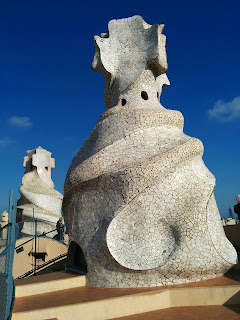We spent the weekend in Oldenburg, where we have good friends. They had just remodelled their house, and we are among the first visitors to the new arrangement (arrangment doesn't do it justice: rooms were repurposed, almost all the floors were replaced -- with some wonderful light wood in the living area, skylights were installed, a very fancy exercise area -- complete with sauna -- was installed) -- all set up for the way they live (including two home offices). We spent a weekend of "Gemütlichkeit", where we caught up on each other's various life activities, ate Kuchen (a necessary part of any visit here -- they have access to a fantastic bakery), went for a walk (between the rainstorms) and just relaxed. It was an enjoyable time. Unfortunately for the blog, I didn't take any pictures.
Now we are back, doing the last minute things we need to do before the cab picks us up at 7am (we will get to the Frankfurt airport 3 hours before our plane is supposed to leave -- I hope that is enough to get through security after all the crackdown due to the Paris attacks). We will probably come again, so we have collected all the extra stuff we have accumulated (from tea to a can opener) for them to store for us at the university for next time. I also had my last German lesson. I'm much more facile with both the passive and the subjunctive now, as well as maybe finally getting my adjective endings mostly right.
Yesterday there was a break in the rain, and I decided that I really needed a walk (those of you who follow me on fitbit will have noticed a real decrease in my daily stepcount since the rains appeared). Here are some pictures of fall in Germany, just as eye candy
A typical path through the woods
German forests in the fall
Those are mostly beech trees
German "neatness" in planting trees.
Almost all the trees in these woods were manually planted
(You can see one older tree that might have naturally grown there in the background),
but in such careful, regular rows.
This building, sort of like an old manor house, is in the middle of the woods.
Even with Google maps, I couldn't figure out how you would get there in a car.
It seems to be abandoned now -- you can sort of see the security fence surrounding it.
I have no idea what it was before.
One of the random brooks I walk by.
Another brook.
I have no idea what that piece of fence once belonged to.
Another visit to the wild pigs.
Here are all the babies napping together to keep warm.
And to end with, random observations on Germany.
- the university here (Universitaet Duisburg-Essen) is pretty much a commuter school. They recently built some very large lecture halls. Today I was walking by the Uni, apparently right before a class was to begin. It was unnerving to see three buses stop by the big hall and unload about 150 students, who marched almost in formation to class (the way you could tell it wasn't a marching group is that most of them were looking at their phones :-). Can't say I have ever seen that before, though I don't think I have visited commuter schools elsewhere
- I found a knitting/yarn store that has "knitting group" hours a couple of times a week. Next visit (we think we will be back -- science marches forward) I am thinking of bringing my knitting there and seeing if I can keep up with the conversation (and knit at the same time).
- On our way to Oldenburg, we passed through Emden, where one great-great-grandmother was born and changed trains in Leer where my grandfather was born. I think that next trip I may go back there and try to get permisson to go through old church records to see what I can find out about my ancestors who came from Ostfriesland to Iowa. One thing I noticed is that, even though the part of Iowa I am from is arguably the richest part of Iowa (based on farmland prices), the farms here looked more prosperous. Maybe my ancestors shouldn't have left.
















































